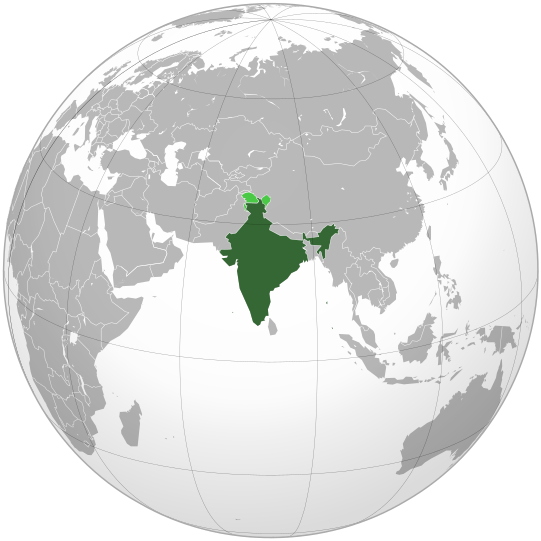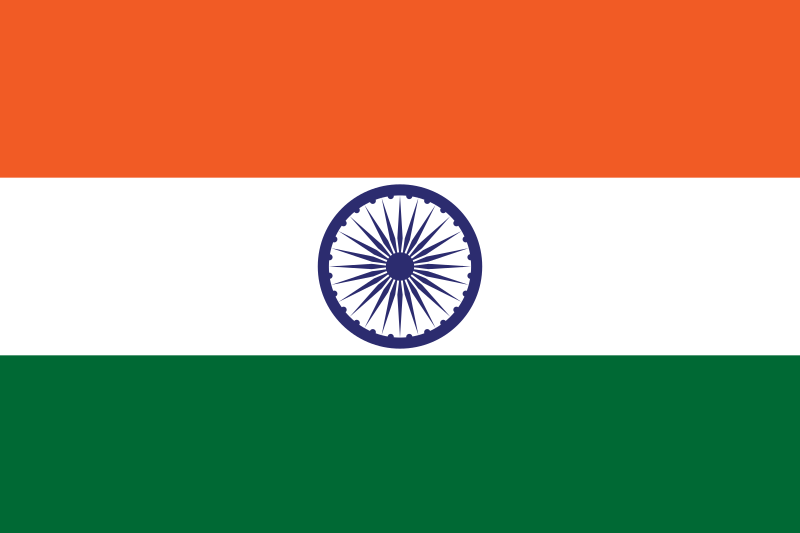Hello
World !
India, the most beautiful land on the earth.
What do you know about India?
I know you’re very curious to know about ancient India.
Friends, well-come on my blog “Lets Know India”
India, officially the Republic of India (Bharat Gaṇarajya),is a country in South Asia. It is the seventh- largest country by area, the second-most populous country (with over 1.2 billion people), and the most populous democracy in the world. It is surrounded by the Indian Ocean on the south, the Arabian Sea on the southwest, and the Bay of Bengal on the southeast. It shares land borders with Pakistan to the west; China, Nepal, and Bhutan to the northeast; and Myanmar (Berma) and Bangaladesh to the east. In the Indian Ocean, India is in the vicinity of Sri Lanka and the Maldives. India's Andaman and Nicobar Islands share a maritime border with Thailand and Indonesia.
The
name India is derived from Indus, which originates
from the Old Persian word Hindu.The latter term stems from the Sanskrit word Sindhu, which was the historical local
appellation for the Indus River. The ancient Greeks referred to the Indians as Indoi ,
which translates as "The people of the Indus".
Hindustan is a Persian name for India dating back to the 3rd century BCE. It
was introduced into India by the Mughals and widely used since then.
Some facts about India
Republic
of India
Bharat Gaṇarajya |
||||||||||
|
||||||||||
Motto: "Satyameva Jayate" (Sanskrit)
"Truth Alone Triumphs" |
||||||||||
Anthem: "Jana Gana Mana ( Hindi) |
||||||||||
National
song
"Vande Mataram" (Sanskrit) |
||||||||||

.
|
||||||||||
Capital
|
New Delhi
|
|||||||||
Largest
city
|
Mumbai
|
|||||||||
Official languages
|
Hindi
English
|
|||||||||
Recognised regional languages
|
Assamese ,Bengali
Bodo · Dogri Gujrati
Kannad · Kashmiri ·Kokborok
Konkani ·Maithili · Malayalam
Manipuri·Marathi·Mizo·Nepali
Odia·Punjabi·Sanskrit·Santali
Sindhi·Tamil·Telugu.Urdu
|
|||||||||
National langauge |
None
|
|||||||||
Religion
|
79.8% Hiduism
14.2% Islam 2.3% Christianity 1.7% Sikhism 0.7% Buddhism 0.4% Jainism 0.9% others |
|||||||||
Government
|
Federal Parlimentory
Constitutional Republic
|
|||||||||
President
|
Pranab Mukherjee
|
|||||||||
Vice President
|
Mohammad Hamid Ansari
|
|||||||||
• Prime Minister
|
Narendra Modi
|
|||||||||
• Chief Justice
|
Jagdish Singh Khehar
|
|||||||||
Lok Sabha Speaker |
Sumitra Mahajan
|
|||||||||
Legislature
|
Parliment Of India
|
|||||||||
• Upper House
|
Rajya Sabha
|
|||||||||
• Lower House
|
Lok Sabha
|
|||||||||
Independance from United Kingdom
|
||||||||||
• Dominion
|
15 August 1947
|
|||||||||
• Republic
|
26 January 1950
|
|||||||||
Area
|
||||||||||
• Total
|
3,287,263 km2
(1,269,219 sq mi)(7th)
|
|||||||||
• Water (%)
|
9.6
|
|||||||||
Population
|
||||||||||
• 2017 estimate
|
1,326,572,000 (2nd)
|
|||||||||
• 2011 census
|
1,210,854,977 (2nd)
|
|||||||||
• Density
|
392.6/km2
(1,016.8/sq mi) (31st)
|
|||||||||
GDP (PPP)
|
2017 estimate
|
|||||||||
• Total
|
$9.489 trillion (3rd)
|
|||||||||
• Per capita
|
$7,153 (122nd)
|
|||||||||
GDP (nominal)
|
2017 estimate
|
|||||||||
• Total
|
$2.454 trillio (7th)
|
|||||||||
• Per capita
|
$1,850 (141st)
|
|||||||||
GINI (2013)
|
33.9
medium · 79th |
|||||||||
HDI (2015)
|
medium · 131st |
|||||||||
Currency
|
Indian Rupee (₹) (INR)
|
|||||||||
Time zone
|
IST (UTC+05:30)
|
|||||||||
DST is not observed
|
||||||||||
Date format
|
DD-MM-YYYY
|
|||||||||
Drives on the
|
Left
|
|||||||||
Calling code
|
+91
|
|||||||||
States In India
| ||||||||||
No.
|
State
|
Capital
|
Population
|
|||||||
1
|
Andhra Pradesh
|
Hyderabad
|
84,665,533
|
|||||||
2
|
Arunachal Pradesh
|
Itanagar
|
1,383,727
|
|||||||
3
|
Assam
|
Dispur
|
31,205,576
|
|||||||
4
|
Bihar
|
Patna
|
104,099,452
|
|||||||
5
|
Chhattisgarh
|
Raipur
|
25,545,198
|
|||||||
6
|
Goa
|
Panaji
|
1,458,545
|
|||||||
7
|
Gujarat
|
Gandhinagar
|
60,439,692
|
|||||||
8
|
Haryana
|
Chandigarh
|
25,351,462
|
|||||||
9
|
Himachal Pradesh
|
Shimla
|
6,864,602
|
|||||||
10
|
Jammu and Kashmir
|
Srinagar
|
12,541,302
|
|||||||
11
|
Jharkhand
|
Ranchi
|
32,988,134
|
|||||||
12
|
Karnataka
|
Bengaluru
|
61,095,297
|
|||||||
13
|
Kerala
|
Thiruvananthapuram
|
33,406,061
|
|||||||
14
|
Madhya Pradesh
|
Bhopal
|
72,626,809
|
|||||||
15
|
Maharashtra
|
Mumbai
|
112,372,972
|
|||||||
16
|
Manipur
|
Imphal
|
2,855,794
|
|||||||
17
|
Meghalaya
|
Shillong
|
2,966,889
|
|||||||
18
|
Mizoram
|
Aizawl
|
1,097,206
|
|||||||
19
|
Nagaland
|
Kohima
|
1,978,502
|
|||||||
20
|
Orissa
|
Bhubaneswar
|
41,974,218
|
|||||||
21
|
Punjab
|
Chandigarh
|
27,743,338
|
|||||||
22
|
Rajasthan
|
Jaipur
|
68,548,437
|
|||||||
23
|
Sikkim
|
Gangtok
|
610,577
|
|||||||
24
|
Tamil Nadu
|
Chennai
|
72,147,030
|
|||||||
25
|
Telangana
|
Hyderabad
|
3,943,323
|
|||||||
26
|
Tripura
|
Agartala
|
3,673,917
|
|||||||
27
|
Uttar Pradesh
|
Lucknow
|
199,581,477
|
|||||||
28
|
Uttarakhand
|
Dehradun
|
10,086,292
|
|||||||
29
|
West Bengal
|
Kolkata
|
91,276,115
|
|||||||
No.
|
Union Territory
|
Capital
|
Population
|
|||||||
1
|
Delhi
|
Delhi
|
16,787,941
|
|||||||
2
|
Puducherry
|
Pondicherry
|
1,247,953
|
|||||||
No.
|
Union Territory
|
Capital
|
Population
|
|||||||
1
|
Andaman and Nicobar Islands
|
Port Blair
|
380,581
|
|||||||
2
|
Chandigarh
|
Chandigarh
|
1,055,450
|
|||||||
3
|
Dadra and Nagar Haveli
|
Silvassa
|
343,709
|
|||||||
4
|
Daman and Diu
|
Daman
|
243,247
|
|||||||
5
|
Delhi
|
Delhi
|
16,787,941
|
|||||||
6
|
Lakshadweep
|
Kavaratti
|
64,473
|
|||||||
7
|
Puducherry
|
Podicherry
|
1,247,953
|
|||||||
India is
one of the world's oldest civilizations and one of the most populated countries
in the world. The Indian culture, often labeled as an amalgamation of
several various scultures, spans across the Indian subcontinent and has been
influenced and shaped by a history that is several thousand years old Throughout
the history of India, Indian culture has been heavily influenced by Dharmic religions. They have been credited with shaping much of Indian Philosophy, literature, architecture,art and music. Greater India was the historical extent of Indian culture beyond the Indian subcontinent.
India is the birthplace of
Hinduism, Buddhism, Jainism and Sikhism, collectively known as Indian religions.
Today, Hinduism and Buddhism are the world's third and fourth-largest religions
respectively, with over 2 billion followers altogether, and possibly as
many as 2.5 or 2.6 billion followers Followers of Indian religions – Hindus,
Sikhs, Jains and Buddhists make up around 80–82% population of India.
India is
one of the most religiously and ethnically diverse nations in the world, with
some of the most deeply religious societies and cultures. Religion plays a
central and definitive role in the life of many of its people. Although India
is a secular Hindu-majority country,
it has a large Muslim population.
There are various religions, caste,sub-castes,differences in
dressing,eating habits existed in India. Many sub cultures
existed within a broader Indian culture.
But what is specialty of India ?
The answer is Unity In Diversity.
dressing,eating habits existed in India. Many sub cultures
existed within a broader Indian culture.
But what is specialty of India ?
The answer is Unity In Diversity.
Now, it is enough for 1st post. I will come back soon............
Have a good day !
Have a good day !






No comments:
Post a Comment